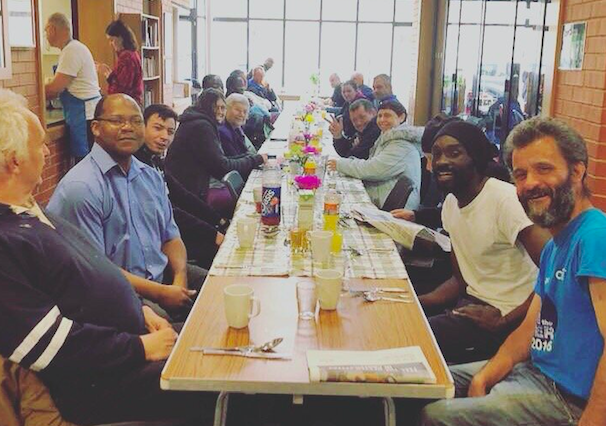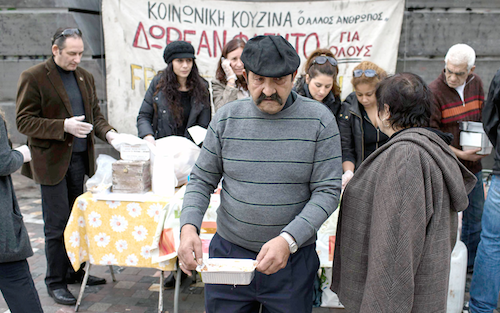We’re republishing the following piece as we think its adds some useful stuff to the discussion on community organising. It was published in January in Freedom News, originally posted on the South Norwood Community Kitchen blog.
Community kitchens are popping up all around the country and they are truly spaces that can make the world a better place, create friendships and make our neighbourhood feel more connected. One myth that needs to be dispelled is that community kitchens are not only for those in dire need and should be and are for everyone regardless of if you can afford a meal or not. Bringing people together from different backgrounds, as we have seen, can heal divisions and dismantle a lot of preconceptions that some people don’t always realise they have – all through the power of a shared meal!
Here are some key ingredients that we have found to be fundamental in running a successful community kitchen. We are by no means experts and we are constantly learning and evolving but these are a few things we have learned so far.
1. Venue
Probably the most important thing is having a space to host your community kitchen. These can come in all shapes and sizes: Community centres, village halls, churches and other places of worship, street corners, parks in summer, restaurants and cafés out of hours. We have been very lucky to be hosted by the South Norwood Baptist Church for the last 3 years but we will be moving to our own venue at the Socco Cheta Community Hub so that we can operate 6 days a week and provide more activities and support for the community.
You need as decent a kitchen as you can find, unless you are cooking in your own homes and serving it on the street. If you are serving the public, you will need to make sure it has been inspected by the council’s food hygiene team and if it is inside then make sure you have enough space for at least 40 guests. You often have to make do with what you can get but creating a clean and safe environment is a must.
2. Food
There are a number of ways to get food. Fareshare is a charity that redistributes surplus food to charities and not-for-profit organisations. We have had wonderful donations from them ranging from whole lambs, cheese, birthday cakes and an abundance of fruit and veg. City Harvest is also a reliable supplier and can provide high quality vegetables alongside chilled food if you can handle it appropriately at your venue. You can also ask your local supermarkets for food donations but being frank, the quality of food you receive can vary depending on the supermarket you use and their interest in the cause. They also may need reminding as staff shifts can change and may not be aware of your regular collection date.
The food you provide should obviously be tasty but also nourishing. Not every kitchen has the resource to provide a 3 course menu but giving your guests some decent food that feels like it’s made with love can give a bit of dignity and just because something is free doesn’t mean it has to be rubbish. We choose to serve people at their table, clear up after them and treat them as if they were dining in our restaurant for the same reason.
3. Volunteers
Volunteers are the lifeblood of community kitchens. We are lucky at SNCK to have such committed and passionate volunteers and also to those who are with us briefly but allow us to never miss a service because we are short of people power. Having a sign-up rota (we use sign-up.com) is fundamental so you can see how many volunteers you have for the week and to make sure you can fill any upcoming gaps. We have seen patterns in volunteer numbers as the seasons flow. Summer can be quiet with Christmas and the new year good will giving healthy numbers earlier in the year. Take advantage of these moments and be mindful to find ways to boost your numbers as that warm weather beckons.
Of course, volunteers when they start need to be supported to learn the ropes and understand any health and safety issues, but they should also have the freedom to just get stuck in and make suggestions on how the project runs or could be improved.
Volunteers can come from many different channels, through your social media posts and in community facebook groups, your guests that attend, asking neighbours and friends, and also through your local volunteer centre or voluntary support organisation.
4. Spreading the word and getting the community on board
Give it a good name and an identity but without any of the corporate malarkey. People need to know who you are and where you are. Get your project on the council lists for free meals,, social prescribing databases and local noticeboards. Put posters around the area, post on Facebook groups and use the most effective method of all, word of mouth around your local networks.
As the name says, a community kitchen is nothing without its community. Getting your community onboard is the best support you can receive, they will be your guests that attend, source of all kinds of donations and an all-round cheerleader for your project. Collaborating is also key, always look for opportunities to partner with other local charities and organisations or with local businesses. We have worked with local youth organisations who have volunteered with us to our local community cinema who we are about to do a lunch and film screening with. Partnerships can yield people power for your project, donations and also more support for your guests that attend.
5. Solidarity not charity
We have nicked this phrase from the epic Streets Kitchen but it couldn’t be more true. The Victorian charity model of feeding the poor and homeless does little to help people move beyond feeling like victims and empower them to build more supported, resilient lives. Guests that walk through those doors should be made to feel valued, empowered and listened to. Providing opportunities for guests to volunteer or take ownership over some part of the project can go a long way in facilitating this.
Community kitchens are great ways of being hubs of informal advice and support for the community. Of course, getting in official advice providers can be useful particularly around finances, housing etc. but creating a space where everyone can share experiences or offer help when someone needs it offers immediate solutions. This has happened in many ways at SNCK, when someone needs something like a new fridge because they’ve finally got somewhere to live or a lift to the hospital then we know among us or reaching out to the wider community, that we can sort it.
6. Make it fun
This is a vital ingredient. Making a fun and vibrant space that people want to return to and to feel a part of. A quiet environment punctuated by slurps of soup and clattering cutlery may suit some but is not always conducive to encouraging people to chat and relax. Stick on a bit of music (funk and soul always works in our case), encourage a bit of dancing or put on some kind of activity like Bingo. We like to have fun in the kitchen too and volunteers will play with the menu and have a laugh through what is mainly chopping vegetables and washing up!
Community kitchens can be hard work and take a while to establish themselves and get the support that they need but they are worth every minute. When you see those new friendships made, the satisfied faces, the raucous laughter, the dance offs, the hugs and kisses and as one guy once said to us ‘this place is like coming home’, it makes it all worthwhile.



